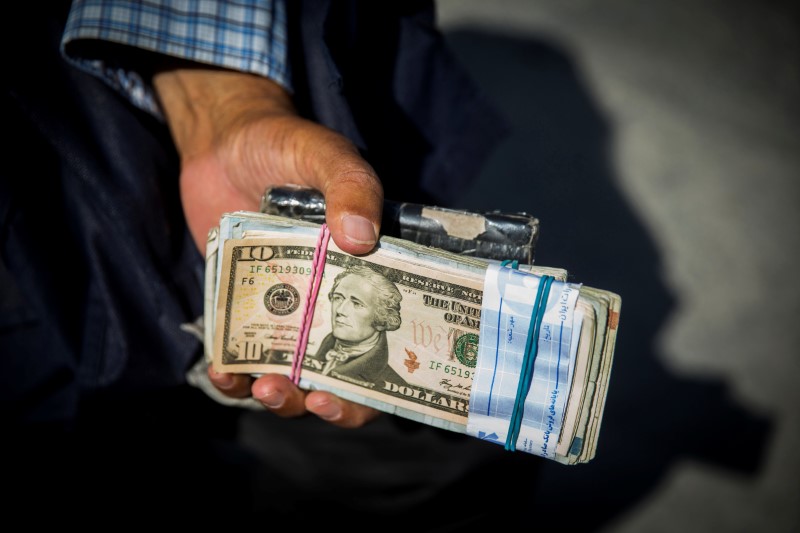By Saikat Chatterjee
LONDON (Reuters) - Far from indicating the U.S. economy is struggling or the "Trump discount" unraveling, the weak dollar may be a sign that arguably the most benign investment conditions for a decade are likely to persist a while longer.
U.S. stock markets are at record highs, with the S&P 500 index (SPX) up a solid 10 percent this year, and measures of volatility (VIX) have never been lower. At the same time, the dollar is down 10 percent this year and at 15-month lows against a basket of major currencies (DXY).
With the dollar as the world's main funding currency, investors had worried until recently that the twin forces of U.S. interest rate hikes and a strengthening dollar would derail the rally in global stocks.
Before this year's drop, the dollar (DXY) had posted its best three-year rolling performance against its currency basket in more than three decades. A stronger dollar indicates tightening global financial conditions.
Conversely, as Morgan Stanley (NYSE:MS) says in a note, a 2 percent dollar decline is equivalent to a 25 basis point cut in the U.S. federal funds rate in terms of impact on financial conditions.
The greenback’s 8 percent fall since April has also coincided with a decline in expectations of U.S. rate increases fueling an extended rally in global stock markets.
This week, the blue-chip Down Jones Industrial Average (DJI) scaled a peak of 22,000 for the first time.
While doubts about U.S. President Donald Trump's longevity in the White House or his ability to pass key reforms have also been cited as headwinds, there is a growing belief that the dollar is reflecting the rude, inflation-less health of an expanding world economy.
“Asset markets and the dollar are reacting to the same thing which is a Goldilocks (not too hot, not too cold) period for the global economy along with a cautious Fed that will continue,” said Kamal Sharma, a director of G10 FX strategy at Bank of America Merrill Lynch (NYSE:BAC) in London.
Investors say the dollar’s decline has further to run as it remains broadly undervalued and that this may fuel further gains in asset markets.
An International Monetary Fund report published last week said the dollar remained overvalued by more than 10 to 20 percent based on U.S. economic fundamentals. JPMorgan's index tracking the dollar's valuation against an inflation-adjusted basket of its peers was still near its long term median.
BRIGHT OUTLOOK
The latest leg of the dollar's drop also comes as the economic outlook beyond the United States has brightened considerably, particularly in the euro zone, encouraging investors to bet on further weakness in the U.S. currency.
Derek Halpenny, head of European global markets research at MUFG in London, said the ratio of unhedged to hedged passive inflows into European equities has surged since the French presidential and parliamentary elections, indicating investors are more comfortable in taking foreign currency exposure while buying assets.
Though those flows have declined from their highs, fund managers remain bullish about the single currency’s outlook, linking it to an improving economy and the prospect of pro-growth reforms.
“A bet on the euro is a bet about French labor reforms rather than any perceived ECB hawkishness and if that goes through, EUR/USD can go above 1.20,” said James Kwok, head of currency management at Amundi Asset Management in London.
In another sign of growing risk appetite, emerging market equities have seen 20 consecutive weeks of inflows while debt funds have seen 27 straight weeks of inflows, according to Bank of America Merrill Lynch flow estimates.
TOO FAR?
Despite the relatively heavy speculative euro bets by hedge funds, large institutional players such as central banks and pension funds remain underweight the euro and related assets, suggesting they could increase exposure to the single currency.
But some say the dollar’s decline has gone too far, with robust profit growth at U.S. companies and likely strong jobs data to provide the impetus for the Fed to start tightening policy quicker than markets are pricing in. Some expect a U.S. rate increase in September, even though futures markets put the probability of no change at 97.5 percent.
Richard Falkenhall, a senior FX strategist at SEB in Stockholm, who shares this contrarian view, said relative monetary policy trends have been a key driver for currency behavior since 2012.

"While the Fed has taken their foot off the policy pedal in recent weeks, the ECB has gone the other way, though that might change in the coming weeks," Falkenhall said.